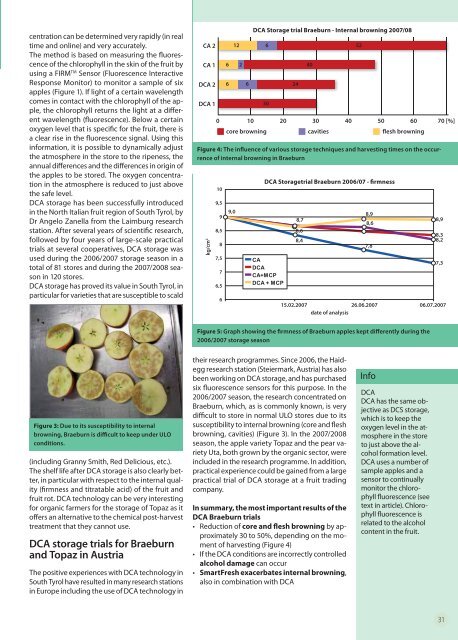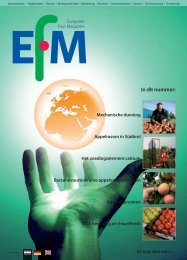In this edition: - The European Fruit Magazine
In this edition: - The European Fruit Magazine
In this edition: - The European Fruit Magazine
Create successful ePaper yourself
Turn your PDF publications into a flip-book with our unique Google optimized e-Paper software.
centration can be determined very rapidly (in real<br />
time and online) and very accurately.<br />
<strong>The</strong> method is based on measuring the fl uorescence<br />
of the chlorophyll in the skin of the fruit by<br />
using a FIRM TM Sensor (Fluorescence <strong>In</strong>teractive<br />
Response Monitor) to monitor a sample of six<br />
apples (Figure 1). If light of a certain wavelength<br />
comes in contact with the chlorophyll of the apple,<br />
the chlorophyll returns the light at a diff erent<br />
wavelength (fl uorescence). Below a certain<br />
oxygen level that is specifi c for the fruit, there is<br />
a clear rise in the fl uorescence signal. Using <strong>this</strong><br />
information, it is possible to dynamically adjust<br />
the atmosphere in the store to the ripeness, the<br />
annual diff erences and the diff erences in origin of<br />
the apples to be stored. <strong>The</strong> oxygen concentration<br />
in the atmosphere is reduced to just above<br />
the safe level.<br />
DCA storage has been successfully introduced<br />
in the North Italian fruit region of South Tyrol, by<br />
Dr Angelo Zanella from the Laimburg research<br />
station. After several years of scientifi c research,<br />
followed by four years of large-scale practical<br />
trials at several cooperatives, DCA storage was<br />
used during the 2006/2007 storage season in a<br />
total of 81 stores and during the 2007/2008 season<br />
in 120 stores.<br />
DCA storage has proved its value in South Tyrol, in<br />
particular for varieties that are susceptible to scald<br />
Figure 3: Due to its susceptibility to internal<br />
browning, Braeburn is diffi cult to keep under ULO<br />
conditions.<br />
(including Granny Smith, Red Delicious, etc.).<br />
<strong>The</strong> shelf life after DCA storage is also clearly better,<br />
in particular with respect to the internal quality<br />
(fi rmness and titratable acid) of the fruit and<br />
fruit rot. DCA technology can be very interesting<br />
for organic farmers for the storage of Topaz as it<br />
off ers an alternative to the chemical post-harvest<br />
treatment that they cannot use.<br />
DCA storage trials for Braeburn<br />
and Topaz in Austria<br />
<strong>The</strong> positive experiences with DCA technology in<br />
South Tyrol have resulted in many research stations<br />
in Europe including the use of DCA technology in<br />
CA 2<br />
CA 1<br />
DCA 2<br />
DCA 1<br />
kg/cm 2<br />
6<br />
12<br />
6 6 24<br />
0 10<br />
10<br />
9,5<br />
9<br />
8,5<br />
8<br />
7,5<br />
7<br />
6,5<br />
6<br />
9,0<br />
DCA Storage trial Braeburn - <strong>In</strong>ternal browning 2007/08<br />
6 52<br />
2 40<br />
30<br />
20 30 40 50 60 70 [%]<br />
core browning cavities fl esh browning<br />
Figure 4: <strong>The</strong> infl uence of various storage techniques and harvesting times on the occurrence<br />
of internal browning in Braeburn<br />
DCA Storagetrial Braeburn 2006/07 - fi rmness<br />
their research programmes. Since 2006, the Haidegg<br />
research station (Steiermark, Austria) has also<br />
been working on DCA storage, and has purchased<br />
six fl uorescence sensors for <strong>this</strong> purpose. <strong>In</strong> the<br />
2006/2007 season, the research concentrated on<br />
Braeburn, which, as is commonly known, is very<br />
diffi cult to store in normal ULO stores due to its<br />
susceptibility to internal browning (core and fl esh<br />
browning, cavities) (Figure 3). <strong>In</strong> the 2007/2008<br />
season, the apple variety Topaz and the pear variety<br />
Uta, both grown by the organic sector, were<br />
included in the research programme. <strong>In</strong> addition,<br />
practical experience could be gained from a large<br />
practical trial of DCA storage at a fruit trading<br />
company.<br />
<strong>In</strong> summary, the most important results of the<br />
DCA Braeburn trials<br />
• Reduction of core and fl esh browning by approximately<br />
30 to 50%, depending on the moment<br />
of harvesting (Figure 4)<br />
• If the DCA conditions are incorrectly controlled<br />
alcohol damage can occur<br />
• SmartFresh exacerbates internal browning,<br />
also in combination with DCA<br />
8,7<br />
8,6<br />
8,4<br />
8,9<br />
8,6<br />
7,8<br />
8,9<br />
8,3<br />
8,2<br />
15.02.2007 26.06.2007 06.07.2007<br />
date of analysis<br />
Figure 5: Graph showing the fi rmness of Braeburn apples kept diff erently during the<br />
2006/2007 storage season<br />
<strong>In</strong>fo<br />
DCA<br />
DCA has the same objective<br />
as DCS storage,<br />
which is to keep the<br />
oxygen level in the atmosphere<br />
in the store<br />
to just above the alcohol<br />
formation level.<br />
DCA uses a number of<br />
sample apples and a<br />
sensor to continually<br />
monitor the chlorophyll<br />
fl uorescence (see<br />
text in article). Chlorophyll<br />
fl uorescence is<br />
related to the alcohol<br />
content in the fruit.<br />
7,3<br />
31



